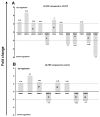Leucocyte-Rich Platelet-Rich Plasma Enhances Fibroblast and Extracellular Matrix Activity: Implications in Wound Healing
- PMID: 32900003
- PMCID: PMC7556022
- DOI: 10.3390/ijms21186519
Leucocyte-Rich Platelet-Rich Plasma Enhances Fibroblast and Extracellular Matrix Activity: Implications in Wound Healing
Abstract
Background: Platelet-rich plasma (PRP) is an autologous blood product that contains a high concentration of platelets and leucocytes, which are fundamental fibroblast proliferation agents. Literature has emerged that offers contradictory findings about leucocytes within PRP. Herein, we elucidated the effects of highly concentrated leucocytes and platelets on human fibroblasts.
Methods: Leucocyte-rich, PRP (LR-PRP) and leucocyte-poor, platelet-poor plasma (LP-PPP) were compared to identify their effects on human fibroblasts, including cell proliferation, wound healing and extracellular matrix and adhesion molecule gene expressions.
Results: The LR-PRP exhibited 1422.00 ± 317.21 × 103 platelets/µL and 16.36 ± 2.08 × 103 white blood cells/µL whilst the LP-PPP demonstrated lower concentrations of 55.33 ± 10.13 × 103 platelets/µL and 0.8 ± 0.02 × 103 white blood cells/µL. LR-PRP enhanced fibroblast cell proliferation and cell migration, and demonstrated either upregulation or down-regulation gene expression profile of the extracellular matrix and adhesion molecules.
Conclusion: LR-PRP has a continuous stimulatory anabolic and ergogenic effect on human fibroblast cells.
Keywords: PRP; extracellular matrix; fibroblasts; leucocytes; platelet gel; platelet-rich fibrin; platelet-rich plasma; wound.
Conflict of interest statement
J.D. is a technician and demonstrates the operation of a variety of cell separating systems and their applications, including Emcyte®, Angel® System and plasma tubes. All other authors declare no conflict of interest.
Figures



References
-
- Roffi A., Filardo G., Assirelli E., Cavallo C., Cenacchi A., Facchini A., Grigolo B., Kon E., Mariani E., Pratelli L., et al. Does platelet-rich plasma freeze-thawing influence growth factor release and their effects on chondrocytes and synoviocytes? Biomed. Res. Int. 2014;2014:692913. doi: 10.1155/2014/692913. - DOI - PMC - PubMed
MeSH terms
LinkOut - more resources
Full Text Sources
Research Materials

